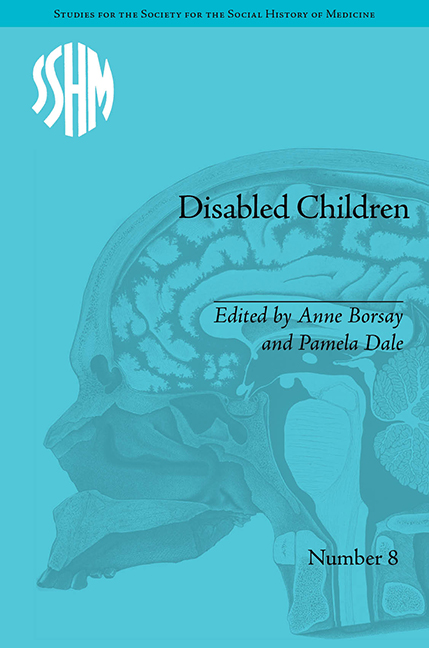Book contents
- Frontmatter
- Contents
- Acknowledgements
- Notes on Contributors
- Introduction: Disabled Children – Contested Caring
- 1 Club Feet and Charity: Children at the House of Charity, Soho, 1848–1914
- 2 Insanity, Family and Community in Late-Victorian Britain
- 3 The Mixed Economy of Welfare and the Care of Sick and Disabled Children in the South Wales Coalfield, c. 1850–1950
- 4 The Question of Oralism and the Experiences of Deaf Children, 1880–1914
- 5 Exploring Patient Experience in an Australian Institution for Children with Learning Disabilities, 1887–1933
- 6 From Representation to Experience: Disability in the British Advice Literature for Parents, 1890–1980
- 7 Treating Children with Non-Pulmonary Tuberculosis in Sweden: Apelviken, c. 1900–30
- 8 Health Visiting and Disability Issues in England before 1948
- 9 Spanish Health Services and Polio Epidemics in the Twentieth Century: The ‘Discovery’ of a New Group of Disabled People, 1920–70
- 10 Cured by Kindness? Child Guidance Services during the Second World War
- 11 Education, Training and Social Competence: Special Education in Glasgow since 1945
- 12 Hyperactivity and American History, 1957–Present: Challenges to and Opportunities for Understanding
- Notes
- Index
10 - Cured by Kindness? Child Guidance Services during the Second World War
- Frontmatter
- Contents
- Acknowledgements
- Notes on Contributors
- Introduction: Disabled Children – Contested Caring
- 1 Club Feet and Charity: Children at the House of Charity, Soho, 1848–1914
- 2 Insanity, Family and Community in Late-Victorian Britain
- 3 The Mixed Economy of Welfare and the Care of Sick and Disabled Children in the South Wales Coalfield, c. 1850–1950
- 4 The Question of Oralism and the Experiences of Deaf Children, 1880–1914
- 5 Exploring Patient Experience in an Australian Institution for Children with Learning Disabilities, 1887–1933
- 6 From Representation to Experience: Disability in the British Advice Literature for Parents, 1890–1980
- 7 Treating Children with Non-Pulmonary Tuberculosis in Sweden: Apelviken, c. 1900–30
- 8 Health Visiting and Disability Issues in England before 1948
- 9 Spanish Health Services and Polio Epidemics in the Twentieth Century: The ‘Discovery’ of a New Group of Disabled People, 1920–70
- 10 Cured by Kindness? Child Guidance Services during the Second World War
- 11 Education, Training and Social Competence: Special Education in Glasgow since 1945
- 12 Hyperactivity and American History, 1957–Present: Challenges to and Opportunities for Understanding
- Notes
- Index
Summary
Introduction
The Second World War arguably marked an important watershed in approaches towards the care of sick and disabled children in Great Britain. While wartime conditions could, deliberately or otherwise, permit the neglect and mistreatment of some vulnerable groups children were the intended beneficiaries of carefully expanded statutory and voluntary sector health and welfare provision. Such services tended to be framed more by a concern about the health of the nation and its future citizens than close attention to individual needs but they nevertheless were used by large numbers of children. Thus the Second World War, like earlier twentieth-century conflicts, encouraged investment in new facilities for diagnosing and treating children who either had, or were at risk of developing, a disabling condition. To an extent such specialist services were subsumed into the wider development of the welfare state after 1945 and have perhaps received less attention from historians than either the school medical services that emerged after the Boer War, or the maternity and child welfare provision established after 1918. They merit a closer look however because although it is certainly true that many of the post-1945 services had their origins, or at least inspiration, in pre-1939 provision the war years encouraged an important change of emphasis as well as an expansion of the scale and scope of provision.
- Type
- Chapter
- Information
- Disabled ChildrenContested Caring, 1850–1979, pp. 145 - 158Publisher: Pickering & ChattoFirst published in: 2014



